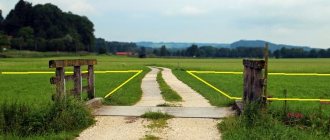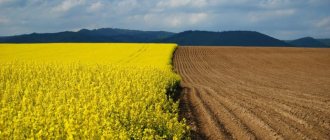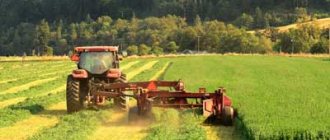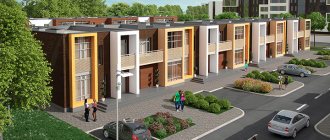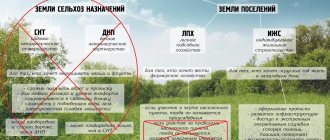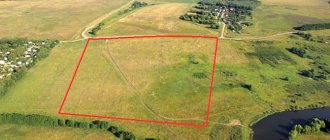It is not difficult to purchase agricultural land; this opportunity is available to both Russian citizens and foreigners. Such plots often range from one to hundreds of hectares and are inexpensive. The purchase is profitable from all points of view, but how to transfer such real estate for individual housing construction in order to build buildings there with the right of registration and postal address, that is the question?
Former state farms often divide their fields and sell them to anyone with the right of privatization. A company can purchase several hectares, transfer them to the individual housing construction category and make a good profit on this.
However, changing the purpose of land is not such a simple task; this requires going through a number of formalities. If this is not done, the authorities most likely will not allow the owner to build at least a garden house. And even if the possibility of construction is provided, it will not be possible to register in a cottage on agricultural land.
Nuances of state land registration
Owners of farmland often, instead of changing the main purpose, use VRI - changing the type of permitted use. The possibility of changing the category of sites is determined by their VRI.
According to Federal Law No. 191, it is possible to add to agricultural purposes the possibility of building a country house, operating it as a residential cottage or private household plot. In this case, local regulations and land use rules established in the selected region are taken into account. The disadvantage of this method is that the owner is still obliged to cultivate the fields like a farmer, since the main purpose does not change.
Changing the purpose allows you to completely convert land intended for agriculture into a new format. But this procedure is more complicated and not always feasible. For example, if initially the subject of consideration belonged to the forest fund, is located near a protected area, etc.
It is important to take into account some subtleties. If the properties are allocated for farmland, from the point of view of the state, products will be grown on them and profits will be made. The definition of agricultural plots for purpose is given in Article 22 of the Land Code of the Russian Federation. When transferred to another category, this profit will no longer be taken into account, so the owner may be required to compensate the state for the difference, which will amount to a considerable amount - it can reach up to 30% of the cadastral valuation of the property.
Grounds for refusal
What grounds may arise for refusing to change the category of land?
- Factual errors in the documentation, incomplete list of collected papers;
- The inappropriateness of changing the category of land, as well as private construction on the territory;
- a ban on the use of an allotment for individual housing construction - such a restriction is typical for agricultural land;
- the applicant has no legal rights to carry out the procedure for changing the category or purpose of the land.
What documents are needed?
As with any registration procedure, the owner must provide certificates and certificates to the authorities. If the site belongs to a populated area, the application is made to the local administration. If not, it is within the competence of the Federal authorities.
To consider your application, it is important to provide:
- a photocopy of an individual’s passport - the first page, with the name of the department that issued the identity card and registration;
- legal entities provide an extract from the Unified State Register and a copy of the Charter;
- foreign citizens must prepare a translation of identification papers that have been certified by a notary;
- petition - a request for transfer to another category;
- a paper confirming the owner’s consent to carry out the procedure;
- cadastral passport;
- a conclusion from ecologists that no damage will be caused to the ecosystem is required if its presence is provided for by the Federal Law.
- calculation of losses for the agricultural or logging industry;
- extract from the Unified State Register.
Procedure
The transfer of agricultural land to individual housing construction is carried out in accordance with Federal Law No. 172. The application is considered by the Federal or local administration within 2-3 months. They are then required to respond within 14 days.
Most often, landowners whose plots are located far from populated areas receive refusals. Usually, according to the general plan, the development of lands located far beyond the boundaries of cities, towns, and villages is not planned. Therefore, obtaining permission to transfer them to individual housing construction is very difficult.
If the application is approved, the applicant is given a certificate confirming the transfer. The following information should be present there:
- on what grounds the permit was issued;
- boundaries of the plot and its number;
- land area;
- the category that was previously and the one that was assigned after a positive decision was made.
Individual housing construction is different...
At the same time, most buyers do not know that the letters individual housing construction designate not only the VRI of land in settlements, but also the object of individual housing construction - that is, the building itself. The paradox is that such a house can legally stand not on individual housing construction land - for example, it can be built on agricultural land for dacha construction. Because of this, confusion periodically arises. Often, buyers believe the promise that the plot they purchased “can be converted to individual housing construction.” The buyer is confident that, having completed certain actions, he will eventually receive a plot of land of the category “land of settlements” with VRI “for individual housing construction”. However, in most cases, all he will be able to do is change the VRI of agricultural land from “gardening” to “dacha construction”, and this is in the best case. Therefore, before buying a plot with such promised prospects, you need to learn the situations in which you can change the category of land.
Changing the purpose of the site. Service cost
Registration on your own will cost several times less than through a commercial company. But this option is only suitable for those who have free time and are ready to understand the legal nuances.
If the applicant takes care of everything himself, he will need to pay for:
- Registration of changes in the cadastre - 1500 rubles;
- Certificate from Rosreestr - about 500 rubles;
- Copying and notarization of certificates - depends on the region and the notary;
- Surveyor services will cost from 10,000 to 50,000 rubles;
- Compensation for profits lost by the state for ungrown agricultural products - up to 30 percent of the cadastral valuation.
For geodetic surveying, it is better to contact a company with a good reputation; there are many fly-by-night companies on the market that can measure boundaries incorrectly. This is fraught with future lawsuits with neighbors.
Reasons for changing the category of land
Initially, agricultural land is intended for the purpose of growing crops or raising livestock. Therefore, the buildings permitted by law on them are storage facilities, cowsheds, pigsties, cellars for root crops, etc. All such buildings absolutely do not require assignment of a postal address and registration for residence.
However, many landowners want to build a cottage or dacha on their plots, which can become property, be inherited, and have value. This does not apply to the above buildings, so they need to have legal status. To do this, they need to be registered as a residential building, not a barn.
If the registration is successful, the site will now be classified as settlement land. The authorities will have to clean the roads and improve the surrounding area. Residents will have the right to demand the installation of communications: gas, water supply, and so on.
Permitted and prohibited activities on such land plots
Before making development plans, a potential buyer of a plot of land should first determine the characteristics of the future land tenure .
It may happen that, having acquired a plot of land, its owner will be faced with the fact that the law does not allow building a dacha on this territory , much less a country house.
How do some land plots differ from others, and how do these differences affect what kind of buildings can be built on them?
The most preferable for future landowners are plots intended for gardening or vegetable gardening.
Gardening and horticulture are essentially different types of activities and, accordingly, permits for the use of these lands also differ from each other.
So, for example, on lands intended for gardening (code 13.1 according to the VRI classifier), various crops can be grown :
- berry;
- vegetable;
- melons and others.
It is allowed to build a temporary shelter on the site so that you can spend some time here without returning to your place of permanent residence.
You can also build:
- shed for storing agricultural implements;
- a cellar for storing grown vegetables and berries;
- shower and toilet.
But that's where the permissions end. The construction of other structures is not provided for by law .
Permits for areas intended for gardening look somewhat different.
There is one caveat to keep in mind here.
The VRI ZU 2021 classifier has two codes for gardening.
VRI with code 1.5 regulates the types of gardening activities for agricultural enterprises operating on large plots of land and selling their products on an industrial scale.
VRI code 13.2 regulates individual activities in areas intended for gardening.
In addition to growing fruits, melons and other agricultural crops, including potatoes, the construction of a garden house on the site is permitted, in which one family can live , since the house cannot be divided into apartments.
Of course, it is allowed to build various utility structures:
- for storing agricultural implements;
- for storing harvested crops;
- household extensions.
How can I change the allowed use of storage?
Changing the type of use is easier than changing the category. In order for local authorities to authorize such an operation, the following documents must be submitted:
- a statement addressed to the head of the administration of the locality;
- extract from the Unified State Register;
- cadastral plan;
- if there are registered buildings, documents for them;
- area plan, including this land plot;
- situational address plan, where the boundaries of adjacent areas are visible;
- if the land is rented and not owned, then approval from the lessor must be provided;
- copies of certificates establishing land ownership;
- applicant's passport;
- when a representative applies, a power of attorney certified by a notary.
When submitting papers in person or through a representative, request a receipt confirming their receipt. The submitted application must be considered no more than 30 days, unless a hearing is held. Otherwise it will take 2 months.
If the application is approved, in most regions of the Russian Federation, no payment is required. But there are densely populated areas where a cash contribution is required, for example, in the Moscow region.
The VRI is reflected in the Unified State Register extract, so after the procedures for changing the type, you will have to submit a document to change the entry in Rosreestr. This is not difficult, and can be done independently through any MFC.
When the transition is impossible in principle:
- Negative assessment by the environmental service.
- Restrictions related to Federal Legislation.
- The request does not comply with the local development plan. For example, if there are forest lands or a nature reserve nearby, a refusal is possible.
What to do if you refuse?
To achieve results, the decision is challenged in court of any authority. If the court satisfies the applicant’s claim, a transition to a new status will take place. Another option is not to change the status, but to change the possible permitted use - VRI.
The procedure for transferring land, in any case, will take time and require legal preparation. The owner may need to consult a specialist. One way or another, transferring agricultural land to individual housing construction is always profitable, even for the subsequent resale of the property.
Did you find this article helpful? Please share it on social networks: Don't forget to bookmark the Nedvio website. We talk about construction, renovation, and country real estate in an interesting, useful and understandable way.
